Microsites can be powerful tools for enhancing the online presence and effectiveness of events. Here are some best practices explaining why you should consider using a microsite for your event:
- **Focused Content**: Microsites allow for focused content related specifically to the event. This ensures that visitors to the site get all the information they need without distractions from unrelated content. Clients can customize the microsite to reflect the theme, goals, and branding of the event, providing a cohesive and immersive experience for attendees.
- **Enhanced Branding**: A microsite provides an opportunity to showcase your event brand in a more targeted and impactful way. You can incorporate brand elements, such as logos, colors, and messaging, throughout the microsite to create a consistent brand experience for visitors.
- **Improved User Experience**: Microsites are designed to be user-friendly and intuitive, making it easy for attendees to navigate and find the information they need. You can organize content in a clear and structured manner, ensuring that attendees can quickly access event details, schedules, speaker information, registration forms, and any other relevant resources.
- **Mobile Optimization**: With the increasing use of mobile devices, it’s essential for event websites to be optimized for mobile viewing. Microsites can be designed with mobile responsiveness in mind, ensuring that attendees can access the site and engage with its content seamlessly across various devices, including smartphones and tablets.
- **Focused Marketing Efforts**: Microsites provide a dedicated platform for marketing and promoting the event. You can leverage various digital marketing strategies, such as email campaigns, social media promotion, and search engine optimization (SEO), to drive traffic to the microsite and generate interest in the event. This focused approach can lead to higher engagement and attendance rates.
- **Data Capture and Analytics**: Microsites can include built-in tools for capturing attendee data and tracking user behavior. You can collect valuable insights into attendee preferences, interests, and interactions with the site, allowing them to refine their marketing strategies, improve event planning, and enhance the overall attendee experience.
- **Integration with Event Technology**: Microsites can integrate seamlessly with other event technology platforms, such as registration systems, ticketing platforms, virtual event platforms, and mobile apps. This integration streamlines the event management process, improves communication with attendees, and provides a cohesive experience across different touchpoints.
- **Post-Event Engagement**: After the event, the microsite can continue to serve as a valuable resource for attendees. You can use the microsite to share post-event content, such as presentation slides, recordings, photos, and attendee feedback surveys. This helps prolong engagement with attendees and reinforces the client’s brand even after the event has ended.
By leveraging these best practices, you can maximize the impact of your events and create memorable experiences for attendees through the use of microsites.
